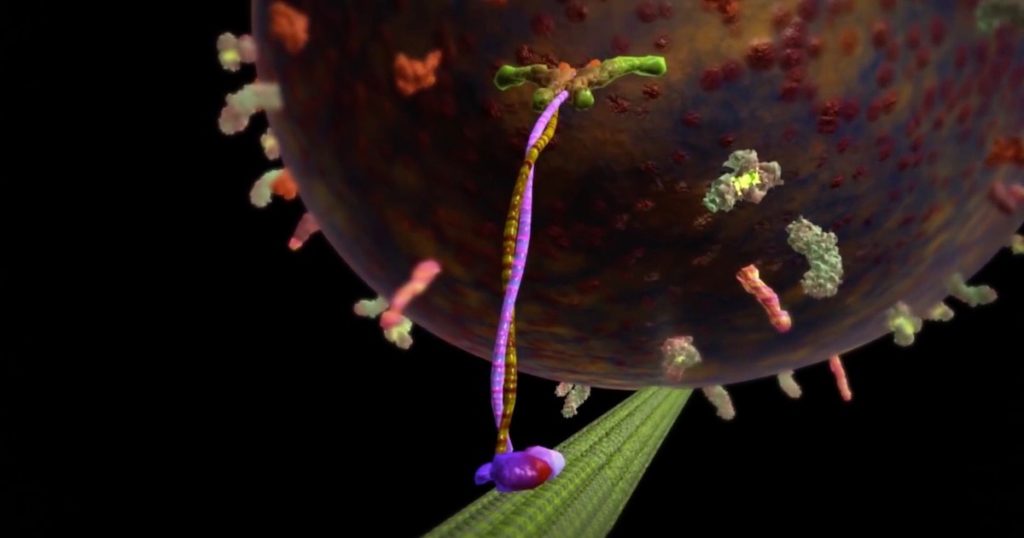 Evolution
Evolution
 Intelligent Design
Intelligent Design
Kinesins: Nanoscale Molecular Motors, Each Built for a Purpose

Editor’s note: We are delighted to welcome biologist Dr. Jared Cochran as a new contributor.
Motors of any kind are a testament to intelligent design. While pondering motors, I went downstairs and asked my eight-year-old son, “What is the difference between a screwdriver and a power drill?” He promptly replied, “A screwdriver is something you turn with your hand. A drill is something you pull the trigger on and a motor turns it.” Isn’t that fascinating? Even at a young age, he is able to recognize similarities and differences in structure and function. He knew right away that both tools needed to move in order to function, and he correctly identified the difference in how the movement of each tool is achieved. Wow, it’s incredible how motors are engineered to accomplish specific tasks!
Consider the multitude of motors we encounter daily. From the simple motor that wiggles our fancy automatic toothbrush back-and-forth, to the complex motor that powers our vehicle as we commute to work. How about the motor that turns the carousel in our microwave, or the powerful electric motor that rotates an impeller at high speed to generate low pressure inside our vacuum cleaner. Linear actuators move our electric car seat forward, backward, up, and down. What about those sliding automatic doors at the grocery store (yes, my eight year old still pretends he is Luke Skywalker every time). These motors work in different ways because they have been designed for specific purposes…to get different types of work done. It is relatively easy for us to see these motors in action and appreciate their intricate design.
Biological Motors
What about the motors inside our cells that we can’t see with our eyes? Molecular motors are enzymes that use chemical energy to generate mechanical force and movement within cells. There are many different types of molecular motors, including cytoskeletal motors, rotary motors, nucleic acid motors, protein synthesis machinery, and dynamic biopolymers. These motors perform a wide range of tasks within cells: transport, cellular respiration, cell motility, nucleic acid manipulation, and cell division. These molecular motors are tiny (just a few nanometers long), and sophisticated experimental methodologies are required to be able to get a glimpse of their intricate design. A deep understanding of their chemistry, structure, and physics is crucial for comprehending the intricacies of these molecular motors and for unraveling diseases associated with their malfunction.
The Workhorse of the Cell
Inside our cells, we have long, string-like polymers (called microtubules) that function as roadways for molecular motors to walk on. Check out this video:
Extensive research has focused on characterizing the structure and function of a group of proteins called kinesins (pronounced KY-knee-sons). Kinesins convert the chemical energy of ATP hydrolysis into directed mechanical movement along microtubules. Typically, kinesins are built with 1) a set of motor domains responsible for harnessing the energy from ATP and generating force, 2) a central stalk domain that holds the motor domains together, and 3) a tail domain with specialized functions for binding different cargo.
Walkers, Hoppers, and More
What is amazing about kinesins is they all get their energy from the same place (ATP hydrolysis), but they seem to use it differently for different tasks inside the cell. Some kinesins are power walkers (like the one in the video above) — taking hundreds of steps along the microtubule before falling off. Others are hoppers — only taking a few steps before letting go of the track. Some kinesins walk forward, some walk backward, and some walk in both directions (trust me…this observation is still quite puzzling from a biophysical perspective). Other kinesins don’t walk at all, but somehow use their ATP energy to trigger the microtubule track to fall apart underneath them.
We have only skimmed the surface over the past four decades since the first kinesin motor was discovered in 1985. Are these differences in function a result of random haphazardness — stochastic tweaking of gene sequences to give infinitesimally small perturbations of amino acids within the motor to eventually (over billions and billions of years) produce a smorgasbord of elegant machines like the kinesin family? Many in the scientific community have faith in this hopeless Darwinian theory. Thankfully, there are a number of scientists who view the nanoscale world with wonder and are open to the idea that molecular machines reflect purpose and design. They see molecular motors as intelligently designed for a reason. These machines must function properly for cells to divide, for essential cargo to be delivered, for biochemical energy to be converted from chemical gradients into stored energy for metabolism, for the propulsion of a cell in a given direction to avoid danger. Studying their chemistry, structure, and physics is our joy and privilege. We have much to learn.
